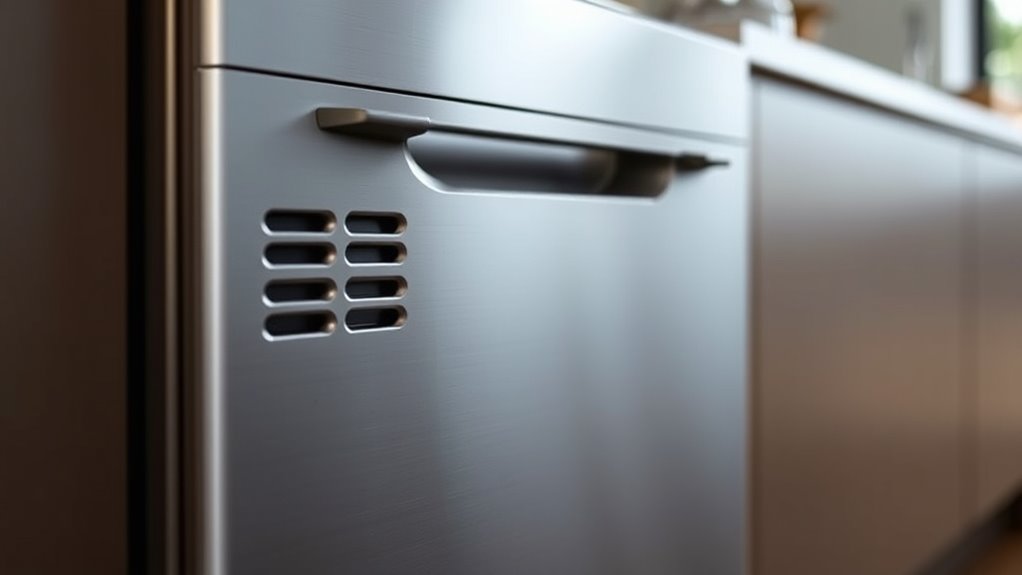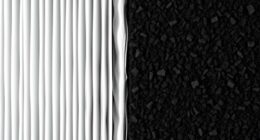Acoustic engineering helps design dishwashers that run quietly without sacrificing cleaning power. It involves identifying sound sources like motors and pumps and using materials such as foam or mineral wool to absorb noise. Engineers also optimize components, like shaping spray arms and applying vibration dampers, to reduce sound. Measuring sound levels during operation guides improvements. To discover how innovative techniques and materials work together to create peaceful kitchens, keep exploring further.
Key Takeaways
- Acoustic engineering analyzes sound sources like motors, pumps, and spray arms to develop targeted noise reduction strategies.
- Soundproofing materials such as foam, mineral wool, and damping pads are applied around key components to absorb vibrations and airborne noise.
- Innovative design features, including shaped spray arms and variable-speed motors, minimize turbulent and mechanical noise during operation.
- Precise measurement and testing with sound level meters and frequency analysis guide the development of quieter dishwasher models.
- Incorporating vibration damping mounts and advanced insulation significantly enhances overall noise reduction and user comfort.
The Role of Acoustic Engineering in Modern Dishwasher Design
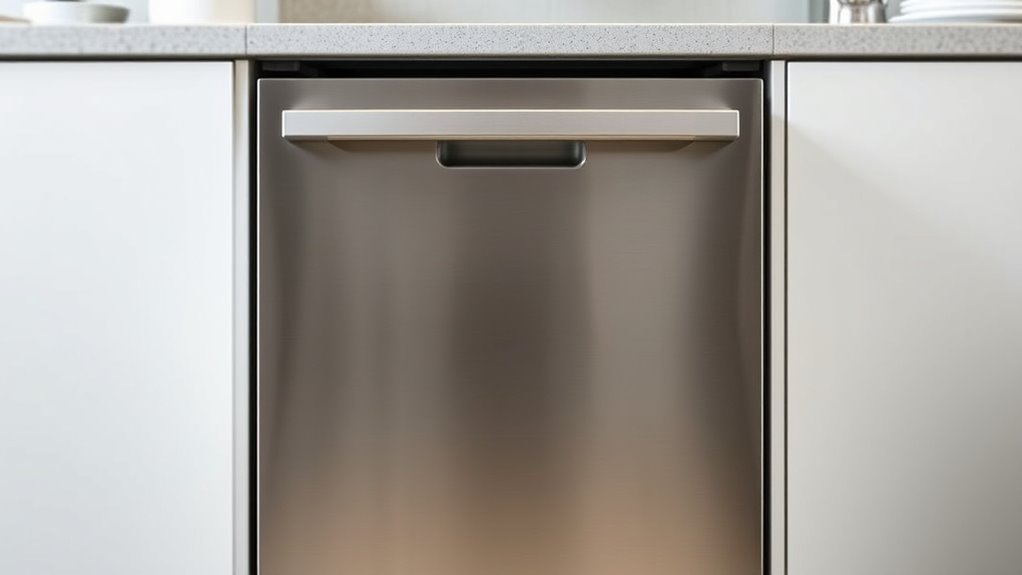
While the primary function of dishwashers is to clean efficiently, their design now heavily emphasizes noise reduction, making acoustic engineering a crucial aspect. You might not notice it, but engineers carefully analyze sound sources within the machine, identifying the loudest components. They then develop strategies to minimize these noises, such as optimizing motor placement or adjusting water flow patterns. Acoustic engineering also involves measuring sound levels during different cycles and conditions, ensuring the dishwasher operates quietly across various settings. Additionally, the choice of soundproofing materials plays a significant role in dampening noise transmission. These materials are selected based on their sound absorption properties to enhance overall noise control. By focusing on sound dynamics, designers can create products that markedly reduce noise without sacrificing cleaning performance. This approach enhances user comfort and satisfaction, especially in open-plan homes, where loud appliances can disrupt daily life.
Soundproofing Materials and Their Application in Dishwashers
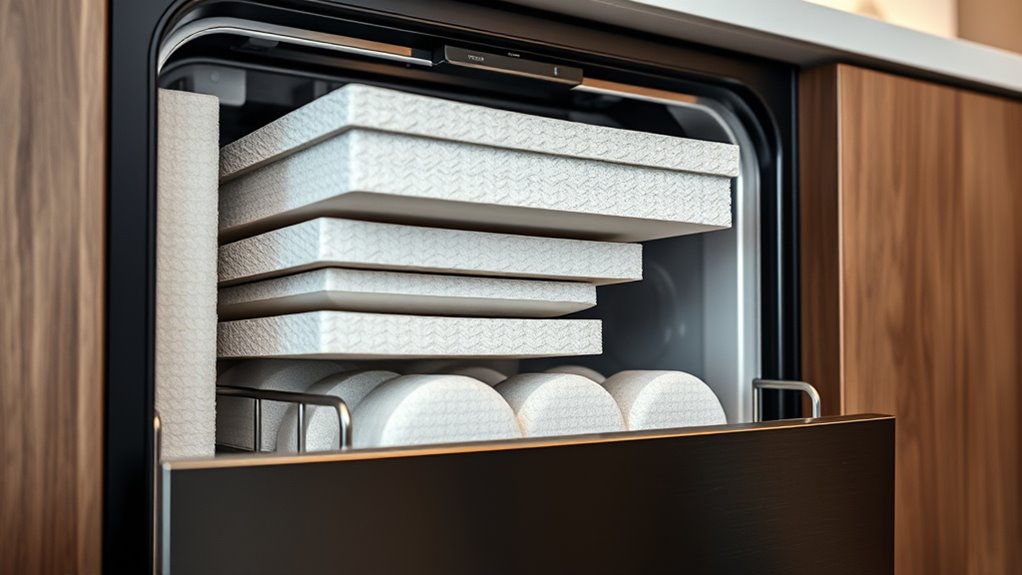
You can improve your dishwasher’s quietness by using absorptive soundproofing layers that reduce noise transmission. Damping mounting techniques also help by minimizing vibrations and resonances within the appliance. Vetted soundproofing materials are highly effective in attenuating noise and can be tailored to fit specific dishwasher models. Additionally, understanding headphone connections can be useful when setting up audio alerts or communication devices around noisy environments. Incorporating Kia Tuning techniques can also inspire innovative ways to optimize appliance performance and noise reduction, ensuring a more comfortable and quieter operation overall. Moreover, utilizing performance cookies data can help manufacturers analyze how design changes impact noise levels and improve future models. Recognizing the importance of regional legal resources can also aid manufacturers in adhering to safety and noise regulations during product development.
Absorptive Soundproofing Layers
Absorptive soundproofing layers play a crucial role in reducing noise generated by dishwashers, effectively dampening vibrations and airborne sound waves. These layers consist of porous materials like foam, mineral wool, or fiberglass, which absorb sound energy rather than reflect it. When installed within the dishwasher’s structure, they trap sound waves, preventing them from escaping into the surrounding environment. You’ll find these layers placed around the motor, pump, and spray arms to target noise at its source. They not only improve silence but also help reduce vibrations that contribute to overall noise. Proper application ensures sound waves are converted into small amounts of heat, minimizing sound transmission. Using absorptive layers is a practical step toward creating a quieter, more comfortable dishwashing experience. Additionally, understanding production quantity variance can help manufacturers identify inefficiencies in the assembly process that might contribute to excess noise. Incorporating soundproofing materials into design can further enhance noise reduction efforts and improve consumer satisfaction. Selecting the right installation method ensures these layers function effectively and last over time. Recognizing the importance of material properties can assist in choosing the most effective soundproofing layers for different dishwasher models. Moreover, considering installation techniques can optimize the performance of these soundproofing layers and extend their lifespan.
Damping Mounting Techniques
Damping mounting techniques are essential for minimizing vibrations and reducing noise in dishwashers by securely isolating components from the chassis. You can achieve this by using resilient mounts, such as rubber or silicone grommets, to absorb vibrations. Applying damping pads or strips between moving parts and the frame prevents sound transmission. You might also consider using spring mounts for heavier components, which help cushion impact and vibrations. Proper placement of these dampers ensures that vibrations don’t amplify or transfer through the dishwasher’s structure. Regular inspection and maintenance keep damping materials effective over time. Additionally, understanding tableware materials can help select damping materials compatible with dishwasher components, enhancing overall soundproofing performance. Considering the cost considerations can help determine the most effective damping solutions within your budget. Incorporating soundproofing methods into the design process can further improve noise reduction. For example, employing vibration isolation techniques can significantly diminish operational noise. Moreover, selecting the appropriate damping materials based on their properties ensures optimal vibration absorption and longevity. By integrating damping mounting techniques, you considerably reduce operational noise, making your dishwasher quieter and more comfortable to use. These methods are crucial for achieving ideal soundproofing in modern dishwashers.
Innovative Engineering Techniques for Noise Reduction

Innovative engineering techniques are transforming how dishwasher noise is minimized, making these appliances substantially quieter. By leveraging advanced materials and design strategies, manufacturers are pushing the boundaries of acoustic performance. For example, you can see:
- The use of sound-absorbing insulation that dampens vibrations at their source.
- Incorporating specially shaped spray arms to reduce turbulent noise.
- Implementing variable-speed motors that operate smoothly, lowering mechanical noise during cycles.
- The integration of Ford Tuning principles to optimize motor performance and reduce operational noise, ensuring quieter cycles and improved efficiency.
These techniques target noise at its origin, ensuring quieter operation without sacrificing performance. By combining smart material choices with innovative component design, engineers create dishwashers that are less disruptive in your home. The result is a more peaceful environment, even when your dishwasher is running at full capacity.
The Impact of Machine Components on Noise Levels
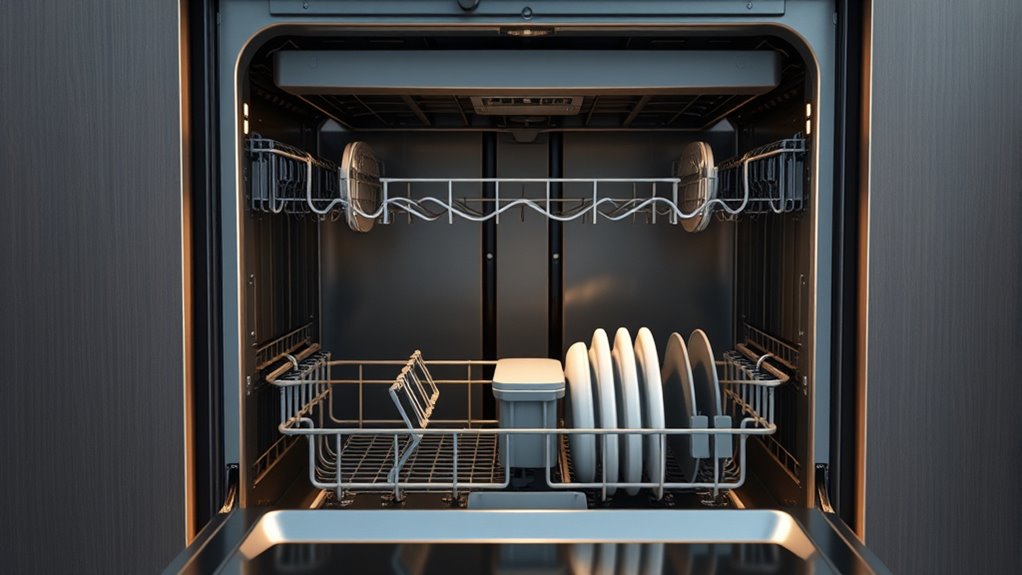
The individual components inside a dishwasher considerably influence its overall noise levels, as each part contributes to the machine’s vibrations and sound emissions. For example, the motor, spray arms, and pump generate different sound frequencies, affecting overall quietness. Properly designed and insulated components can markedly reduce noise. The table below highlights key parts and their impact:
| Component | Effect on Noise | Mitigation Strategy |
|---|---|---|
| Motor | Vibrations produce humming | Use dampening mounts |
| Spray arms | Mechanical noise during operation | Add sound-absorbing seals |
| Pump | Whining sounds at high speeds | Incorporate sound insulation |
Focusing on these parts allows you to understand how each contributes to noise and how engineering solutions can minimize sound emissions.
Testing and Measuring Noise in Dishwashers
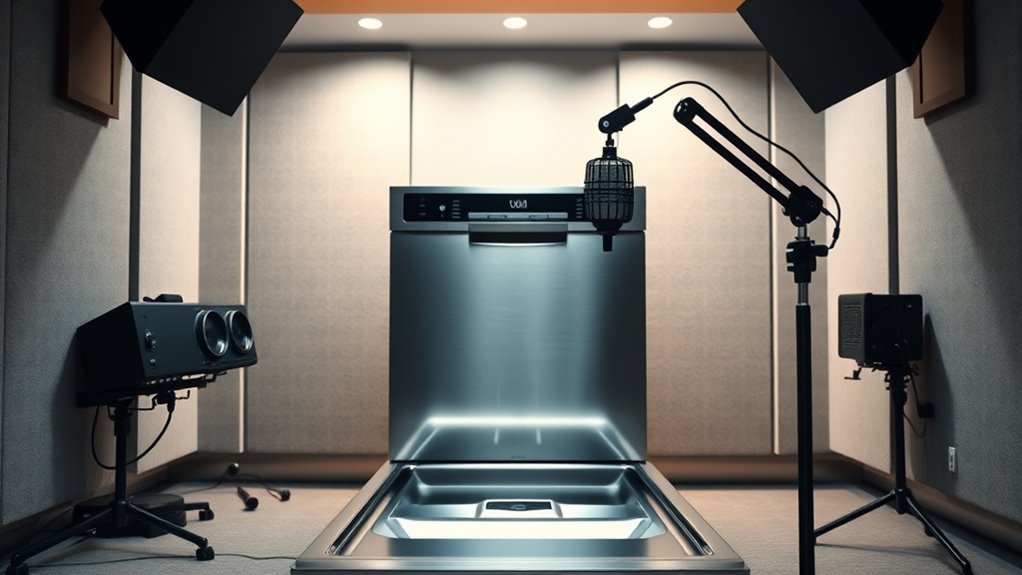
Accurately testing and measuring noise in dishwashers is essential for evaluating their quietness and identifying areas for improvement. You need reliable methods to quantify sound levels and understand how design choices impact noise. To do this effectively, you should consider:
Reliable noise testing is key to designing quieter dishwashers and enhancing user comfort.
- Using standardized testing environments to ensure consistency.
- Employing precision sound level meters positioned at ear level during operation.
- Analyzing frequency spectra to identify dominant noise sources and their characteristics.
Future Trends in Quiet Dishwasher Technology

As technology advances, future dishwasher designs are increasingly focusing on integrating smart features and materials that naturally dampen noise. You can expect machines to incorporate advanced insulation materials that absorb sound more effectively, reducing noise without adding bulk. Smart sensors will likely optimize operation, adjusting cycle speeds and water flow to minimize noise during peak hours. Connectivity features may allow you to monitor and control noise levels remotely, ensuring quiet operation when needed. Additionally, innovative motor technologies and vibration-dampening mounts will further diminish sound transmission. Manufacturers are also exploring the use of adaptive soundproofing solutions that respond dynamically to different washing stages. These trends aim to create quieter dishwashers that seamlessly blend into your home environment while maintaining high performance.
Benefits of Low-Noise Dishwashers for Consumers

Low-noise dishwashers make your kitchen more comfortable by reducing disruptive sounds. They also cut down on noise pollution, creating a calmer home environment. With quieter operation, you can enjoy better sleep and less stress from household noise.
Enhanced Kitchen Comfort
When your dishwasher operates quietly, it transforms your kitchen into a more peaceful space, allowing you to focus on other tasks or enjoy conversations without interruption. This enhanced comfort makes your home feel calmer and more inviting. With a quiet dishwasher, you won’t be startled by loud noises or feel the need to postpone cleaning until late at night. Instead, you can run cycles during family meals, gatherings, or while working from home. Additionally, a low-noise dishwasher minimizes disruptions for your household and guests.
Here are three ways quiet operation boosts your kitchen comfort:
- Creates a tranquil environment for relaxation or work
- Allows flexible scheduling without noise concerns
- Promotes a more harmonious, enjoyable home atmosphere
Reduced Noise Pollution
Reduced noise pollution from dishwashers considerably benefits your daily life by minimizing disruptive sounds in your home. When your dishwasher operates quietly, you can carry on conversations, watch TV, or focus on tasks without constant background noise. It creates a calmer environment, especially during busy mornings or evenings. Low-noise dishwashers also reduce stress, making your home feel more peaceful. You won’t need to worry about loud cycles interrupting your routines or disturbing your family members. Additionally, quieter appliances contribute to a more pleasant living space, increasing your overall comfort. With less noise, you can better enjoy your home’s tranquility and focus on what matters most, all while knowing your dishwasher gets the job done without adding unnecessary noise pollution.
Improved Sleep Environment
Have you ever been kept awake by the loud hum of your dishwasher late at night? Low-noise dishwashers create a more peaceful sleep environment, helping you wake up refreshed. With quieter operation, you won’t be disturbed by unexpected noises that break your concentration or rest. This benefits not only your sleep quality but also reduces stress during late-night chores.
Consider these benefits:
- Better sleep quality, leading to improved overall health.
- Fewer disturbances, promoting deeper rest.
- Reduced noise-related stress, creating a calmer home atmosphere.
Frequently Asked Questions
How Does Acoustic Engineering Influence Dishwasher Energy Efficiency?
You might wonder how acoustic engineering impacts dishwasher energy efficiency. When engineers design quieter dishwashers, they optimize motor and pump sounds, which often involves reducing noise without increasing energy use. By fine-tuning components and soundproofing, they prevent excessive energy loss from vibrations or inefficient parts. This balance guarantees your dishwasher operates quietly and efficiently, saving energy while maintaining performance, making your appliance both eco-friendly and more pleasant to use.
Can Noise Reduction Affect Dishwasher Durability and Performance?
Reducing noise can positively impact your dishwasher’s durability and performance. When noise levels are minimized, it often means the machine operates more smoothly, reducing wear on components. Acoustic engineering techniques, like improved insulation and vibration dampening, help prevent damage from excessive vibrations. As a result, your dishwasher lasts longer and performs better, all while operating quietly, enhancing your overall kitchen experience without sacrificing efficiency or reliability.
Are There Regulations Governing Noise Levels in Dishwashers Worldwide?
Imagine a world where silence is a universal language; regulations aim to make that a reality. You’ll find that many countries, like the EU and the US, set specific noise level limits for dishwashers, ensuring comfort and compliance. These standards act as a shield, protecting consumers from disruptive noise. While regulations vary globally, they all promote quieter appliances, making your kitchen a more peaceful place to cook, clean, and gather.
What Role Do User Settings Play in Managing Dishwasher Noise?
User settings let you control how loud your dishwasher runs. By selecting quiet or energy-saving modes, you reduce noise levels markedly. You can also adjust cycle durations and intensity, which impacts sound output. These options give you flexibility to balance cleaning power and noise, making your experience more comfortable. Always check your dishwasher’s manual to understand how to optimize these settings for quieter operation and better overall performance.
How Do Different Water Temperatures Impact Operational Noise?
Different water temperatures considerably impact your dishwasher’s noise levels during operation. When you select higher temperatures, the system works harder to heat the water, which can increase noise from the heating element and water circulation. Conversely, lower temperatures reduce the workload, making the cycle quieter. You can manage noise by choosing appropriate temperature settings for your needs, balancing cleaning performance with a quieter experience.
Conclusion
Just as a silent river flows smoothly beneath the surface, the advancements in acoustic engineering make your dishwasher quietly hum, almost unnoticed. With innovative materials and design techniques, you’ll enjoy peaceful kitchens where noise is a thing of the past. Embrace these cutting-edge solutions, and you’ll experience the serenity of a well-engineered appliance—like a whisper in a busy world—bringing calm and comfort to your daily routine.
